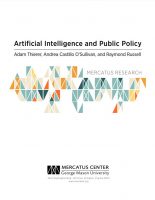On August 1, Sens. Mark Warner and Cory Gardner introduced the “Internet of Things Cybersecurity Improvement Act of 2017.” The goal of the legislation according to its sponsors is to establish “minimum security requirements for federal procurements of connected devices.” Pointing to the growing number of connected devices and their use in prior cyber-attacks, the sponsors aims to provide flexible requirements that limit the vulnerabilities of such networks. Most specifically the bill requires all new Internet of Things (IoT) devices to be patchable, free of known vulnerabilities, and rely on standard protocols. Overall the legislation attempts to increase and standardize baseline security of connected devices, while still allowing innovation in the field to remain relatively permissionless. As Ryan Hagemann[1] at the Niskanen Center states, the bill is generally perceived as a step in the right direction in promoting security while limiting the potential harms of regulation to the overall innovation in the Internet of Things.
Continue reading →
 The Mercatus Center at George Mason University has just released a new paper on, “Artificial Intelligence and Public Policy,” which I co-authored with Andrea Castillo O’Sullivan and Raymond Russell. This 54-page paper can be downloaded via the Mercatus website, SSRN, or ResearchGate. Here is the abstract:
The Mercatus Center at George Mason University has just released a new paper on, “Artificial Intelligence and Public Policy,” which I co-authored with Andrea Castillo O’Sullivan and Raymond Russell. This 54-page paper can be downloaded via the Mercatus website, SSRN, or ResearchGate. Here is the abstract:
There is growing interest in the market potential of artificial intelligence (AI) technologies and applications as well as in the potential risks that these technologies might pose. As a result, questions are being raised about the legal and regulatory governance of AI, machine learning, “autonomous” systems, and related robotic and data technologies. Fearing concerns about labor market effects, social inequality, and even physical harm, some have called for precautionary regulations that could have the effect of limiting AI development and deployment. In this paper, we recommend a different policy framework for AI technologies. At this nascent stage of AI technology development, we think a better case can be made for prudence, patience, and a continuing embrace of “permissionless innovation” as it pertains to modern digital technologies. Unless a compelling case can be made that a new invention will bring serious harm to society, innovation should be allowed to continue unabated, and problems, if they develop at all, can be addressed later.
By Brent Skorup and Melody Calkins
Recently, the FCC sought comments for its Media Modernization Initiative in its effort to “eliminate or modify [media] regulations that are outdated, unnecessary, or unduly burdensome.” The regulatory thicket for TV distribution has long encumbered broadcast and cable providers. These rules encourage large, homogeneous cable TV bundles and burden cable and satellite operators with high compliance costs. (See the complex web of TV regulations at the Media Metrics website.)
One reason “skinny bundles” from online video providers and cable operators are attracting consumers is that online video circumvents the FCC’s Rube Goldberg-like system altogether. The FCC should end its 50-year experiment with TV regulation, which, among other things, has raised the cost of TV and degraded the First Amendment rights of media outlets.
The proposal to eliminate legacy media rules garnered a considerable amount of support from a wide range of commenters. In our filed reply comments, we identify four regulatory rules ripe for removal:
- News distortion. This uncodified, under-the-radar rule allows the commission to revoke a broadcasters’ license if the FCC finds that a broadcaster deliberately engages in “news distortion, staging, or slanting.” The rule traces back to the FCC’s longstanding position that it can revoke licenses from broadcast stations if programming is not “in the public interest.”
Though uncodified and not strictly enforced, the rule was reiterated in the FCC’s 2008 broadcast guidelines. The outline of the rule was laid out in the 1998 case Serafyn v. CBS, involving a complaint by a Ukrainian-American who alleged that the “60 Minutes” news program had unfairly edited interviews to portray Ukrainians as backwards and anti-Semitic. The FCC dismissed the complaint but DC Circuit Court reversed that dismissal and required FCC intervention. (CBS settled and the complaint was dropped before the FCC could intervene.)
“Slanted” and distorted news can be found in (unregulated) cable news, newspapers, Twitter, and YouTube. The news distortion rule should be repealed and broadcasters should have regulatory parity (and their full First Amendment rights) restored.
- Must-carry. The rule requires cable operators to distribute the programming of local broadcast stations at broadcasters’ request. (Stations carrying relatively low-value broadcast networks seek carriage via must-carry. Stations carrying popular networks like CBS and NBC can negotiate payment from cable operators via “retransmission consent” agreements.) Must-carry was narrowly sustained by the Supreme Court in 1994 against a First Amendment challenge, on the grounds that cable operators had monopoly power in the pay-TV market. Since then, however, cable’s market share shrank from 95% to 53%. Broadcast stations have far more options for distribution, including satellite TV, telco TV, and online distribution and it’s unlikely the rules would survive a First Amendment challenge today.
- Network nonduplication and syndicated exclusivity. These rules limit how and when broadcast programming can be distributed and allow the FCC to intervene if a cable operator breaches a contract with a broadcast station. But the (exempted) distribution of hundreds of non-broadcast channels (e.g., CNN, MTV, ESPN) show that programmers and distributors are fully capable of forming private negotiations without FCC oversight. These rules simply make licensing negotiations more difficult and invite FCC intervention.
Finally, we identify retransmission consent regulations and compulsory licenses for repeal. Because “retrans” interacts with copyright matters outside of the FCC’s jurisdiction, we encourage the FCC work with the Copyright Office in advising Congress to repeal these statutes. Cable operators dislike the retrans framework and broadcasters dislike being compelled to license programming at regulated rates. These interventions simply aren’t needed (hundreds of cable and online-only TV channels operate outside of this framework) and neither the FCC nor the Copyright Office particularly likes being the referees in these fights. The FCC should break the stalemate and approach the Copyright Office about advocating for direct licensing of broadcast TV content.
 My professional life is dedicated to researching the public policy implications of various emerging technologies. Of the many issues and sectors that I cover, none are more interesting or important than advanced medical innovation. After all, new health care technologies offer the greatest hope for improving human welfare and longevity. Consequently, the public policies that govern these technologies and sectors will have an important bearing on just how much life-enriching or life-saving medical innovation we actually get going forward.
My professional life is dedicated to researching the public policy implications of various emerging technologies. Of the many issues and sectors that I cover, none are more interesting or important than advanced medical innovation. After all, new health care technologies offer the greatest hope for improving human welfare and longevity. Consequently, the public policies that govern these technologies and sectors will have an important bearing on just how much life-enriching or life-saving medical innovation we actually get going forward.
Few people are doing better reporting on the intersection of advanced technology and medicine — as well as the effects of regulation on those fields — than my Mercatus Center colleague Jordan Reimschisel. In a very short period of time, Jordan has completely immersed himself in these complex, cutting-edge topics and produced a remarkable body of work discussing how, in his words, “technology can merge with medicine to democratize medical decision making, empower patients to participate in the treatment process, and promote better health outcomes for more patients at lower and lower costs.” He gets deep into the weeds of the various technologies he writes about as well as the legal, ethical, and economic issues surrounding each topic.
I encouraged him to start an ongoing compendium of his work on these topics so that we could continue to highlight his research, some of which I have been honored to co-author with him. I have listed his current catalog down below, but jump over to this Medium page he set up and bookmark it for future reference. This is some truly outstanding work and I am excited to see where he goes next with topics as wide-ranging as “biohackerspaces,” democratized or “personalized” medicine, advanced genetic testing and editing techniques, and the future of the FDA in an age of rapid change.
Give Jordan a follow on Twitter (@jtreimschisel) and make sure to follow his Medium page for his dispatches from the front lines of the debate over advanced medical innovation and its regulation.
Continue reading →
“First electricity, now telephones. Sometimes I feel as if I were living in an H.G. Wells novel.” –Dowager Countess, Downton Abbey
Every technology we take for granted was once new, different, disruptive, and often ridiculed and resisted as a result. Electricity, telephones, trains, and television all caused widespread fears once in the way robots, artificial intelligence, and the internet of things do today. Typically it is realized by most that these fears are misplaced and overly pessimistic, the technology gets diffused and we can barely remember our life without it. But in the recent technopanics, there has been a concern that the legal system is not properly equipped to handle the possible harms or concerns from these new technologies. As a result, there are often calls to regulate or rein in their use.
In the late 1980s, video cassette recorders (VCRs) caused a legal technopanic. The concerns were less that VCRs would lead to some bizarre human mutation as in many technopanics, but rather that the existing system of copyright infringement and vicarious liability could not adequately address the potential harm to the motion picture industry. The then president of the Motion Picture Association of America Jack Valenti famously told Congress, “I say to you that the VCR is to the American film producer and the American public as the Boston Strangler is to the woman home alone.”
Continue reading →



 The Technology Liberation Front is the tech policy blog dedicated to keeping politicians' hands off the 'net and everything else related to technology.
The Technology Liberation Front is the tech policy blog dedicated to keeping politicians' hands off the 'net and everything else related to technology.